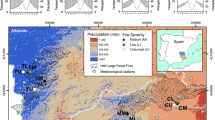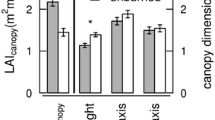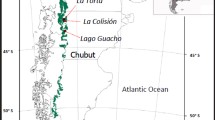Abstract
Key message
Conifers which substantially lost foliage in wildfires were also reduced in their relative hydraulic capacity, resulting in little change in water use efficiency.
Abstract
Wildfires are a natural and ubiquitous component of many forests. Fire-induced damages can lead to immediate tree mortality or a prolonged state of decline. However, physiological mechanisms behind the phenomenon are not well understood. We investigated physiological properties of conifers that survived wildfire 2 year post-fire in central Idaho, USA. In 2005, we set up a burned plot at each of three sites, where the independent wildfires damaged dominant conifers in 2003, paired with a comparable adjacent control plot without any fire damage. At each burned plot, we assessed physical damages in the burned conifers. At each plot in a given site, we repeatedly measured physiological characteristics in five trees of a dominant conifer species (Pseudotsuga menziesii or Pinus contorta) to compare burned and control plots across the three sites during the 2005 growing season. Growth of the burned conifers was significantly reduced post-fire. Leaf area of burned conifers was significantly reduced due to scorching, which, in theory, should have led to increased stomatal conductance (g s) and leaf specific conductance (K L). However, we did not find significant differences in K L between burned and control conifers, and g s was sometimes even lower in burned than control conifers. These results indicate the wildfires reduced capacity of hydraulic apparatus in the surviving conifers, partly due to reduced sapwood area associated with the decreased stem growth post-fire. This was supported by our finding that integrated water use efficiency, assessed via δ13C of woody materials and foliage, was not significantly affected by the wildfires.






Similar content being viewed by others
References
Agee JK (1996) Fire ecology of Pacific Northwest forests. Island Press, Washington DC
Alfaro-Sánchez R, Julio Camarero J, Sánchez-Salguero R, Sangüesa-Barreda G, Las Heras J (2015) Post-fire Aleppo pine growth, C and N isotope composition depend on site dryness. Trees 1–15
Arbellay E, Stoffel M, Sutherland EK, Smith KT, Falk DA (2014) Resin duct size and density as ecophysiological traits in fire scars of Pseudotsuga menziesii and Larix occidentalis. Ann Bot 114:973–980
Aubrey DP, Mortazavi B, O’Brien JJ, McGee JD, Hendricks JJ, Kuehn KA, Teskey RO, Mitchell RJ (2012) Influence of repeated canopy scorching on soil CO2 efflux. For Ecol Manage 282:142–148
Bataineh AL, Brian P. Oswald, Mohammad Bataineh, Daniel Unger, I-Kuai Hung, Daniel Scognamillo (2006) Spatial autocorrelation and pseudo-replication in fire ecology. Fire Ecol 2:107–118
Battipaglia G, De Micco V, Fournier T, Aronne G, Carcaillet C (2014a) Isotopic and anatomical signals for interpreting fire-related responses in Pinus halepensis. Trees 28:1095–1104
Battipaglia G, Strumia S, Esposito A, Giuditta E, Sirignano C, Altieri S, Rutigliano FA (2014b) The effects of prescribed burning on Pinus halepensis Mill. as revealed by dendrochronological and isotopic analyses. For Ecol Manage 334:201–208
Beghin R, Cherubini P, Battipaglia G, Siegwolf R, Saurer M, Bovio G (2011) Tree-ring growth and stable isotopes (13C and 15N) detect effects of wildfires on tree physiological processes in Pinus sylvestris L. Trees 25:627–636
Bert D, Leavitt SW, Dupouey J-L (1997) Variations of wood δ13C and water-use efficiency of Abies alba during the last century. Ecol 78:1588–1596
Blanck Y-L, Rolstad J, Storaunet KO (2013) Low-to moderate-severity historical fires promoted high tree growth in a boreal Scots pine forest of Norway. Scand J For Res 28:126–135
Boerner RE, Lord TR, Peterson JC (1988) Prescribed burning in the oak-pine forest of the New Jersey Pine Barrens: effects on growth and nutrient dynamics of two Quercus species. Am Midl Natural 108–119
Bond BJ, Kavanagh KL (1999) Stomatal behavior of four woody species in relation to leaf-specific hydraulic conductance and threshold water potential. Tree Physiol 19:503–510
Breece CR, Kolb TE, Dickson BG, McMillin JD, Clancy KM (2008) Prescribed fire effects on bark beetle activity and tree mortality in southwestern ponderosa pine forests. For Ecol Manage 255:119–128
Brewer CK, Winne JC, Redmond RL, Opitz DW, Mangrich MV (2005) Classifying and mapping wildfire severity: a comparison of methods. Photogram Eng Remote Sens 71:1311–1320
Brodersen C, McElrone A (2013) Maintenance of xylem network transport capacity: a review of embolism repair in vascular plants. Front Plant Sci 4
Canny MJ, Sparks JP, Huang CX, Roderick ML (2007) Hypothesis. Air embolisms exsolving in the transpiration water—the effect of constrictions in the xylem pipes. Funct Plant Biol 34:95–111
Coomes DA, Grubb PJ (2000) Impacts of root competition in forests and woodlands: a theoretical framework and review of experiments. Ecol Monogr 70:171–207
Dewar R (1995) Interpretation of an empirical model for stomatal conductance in terms of guard cell function. Plant Cell Environ 18:365–372
Dickinson MB, Johnson EA (2004) Temperature-dependent rate models of vascular cambium cell mortality. Can J For Res 34:546–559
Dickinson M, Jolliff J, Bova A (2005) Vascular cambium necrosis in forest fires: using hyperbolic temperature regimes to estimate parameters of a tissue-response model. Aust J Bot 52:757–763
Ducrey M, Duhoux F, Huc R, Rigolot E (1996) The ecophysiological and growth responses of Aleppo pine (Pinus halepensis) to controlled heating applied to the base of the trunk. Can J For Res 26:1366–1374
Fowler JF, Sieg CH (2004) Postfire mortality of ponderosa pine and Douglas-fir: a review of methods to predict tree death. USDA For Ser GTR RM-GTR-132, p 25
Harrington M (1993) Predicting Pinus ponderosa mortality from dormant season and growing-season fire injury. Int J Wildland Fire 3:65–72
Hinckley TM, Lassoie JP, Running SW (1978) Temporal and spatial variations in the water status of forest trees. For Sci 24:a0001–z0001
Holbrook NM (1995) Stem water storage. In: Gartner BL (ed) Plant stems: physiology and functional morphology. Academic Press, San Diego, pp 151–174
Hood SM, Cluck DR, Smith SL, Ryan KC (2008) Using bark char codes to predict post-fire cambium mortality. Fire Ecol 4:57–73
Hungerford RD, Harrington MG, Frandsen WH, Ryan KC, Niehoff GJ (1991) In: Harvey AE, Neuenschwander LF (eds) Influence of fire on factors that affect site productivity. Proceedings of the management and productivity of Western-montane forest soils. USDA
Jain TB, Graham RT (2007) The relation between tree burn severity and forest structure in the Rocky Mountains. USDA For Serv GTR-PSW-203, pp 213–250
Johansen RW, Wade DD (1987) Effects of crown scorch on survival and diameter growth of slash pines. South J Appl For 11:180–184
Johnson D, McCulloh K, Meinzer F, Woodruff D, Eissenstat D (2011) Hydraulic patterns and safety margins, from stem to stomata, in three eastern US tree species. Tree Physiol 31:659–668
Jones H, Sutherland R (1991) Stomatal control of xylem embolism. Plant Cell Environ 14:607–612
Kaufmann MR, Troendle CA (1981) The relationship of leaf area and foliage biomass to sapwood conducting area in four subalpine forest tree species. For Sci 27:477–482
Kavanagh KL, Pangle R, Schotzko AD (2007) Nocturnal transpiration causing disequilibrium between soil and stem predawn water potential in mixed conifer forests of Idaho. Tree Physiol 27:621–629
Kavanagh KL, Dickinson MB, Bova AS (2010) A way forward for fire-caused tree mortality prediction: modeling a physiological consequence of fire. Fire Ecol 6:80–94
Keyser TL, Smith FW, Shepperd WD (2010) Growth response of Pinus ponderosa following a mixed-severity wildfire in the Black Hills, South Dakota. West J Appl For 25:49–54
Koyama A, Kavanagh KL, Stephan K (2010) Wildfire effects on soil gross nitrogen transformation rates in coniferous forests of central Idaho, USA. Ecosystems 13:1112–1126
Koyama A, Kirsten Stephan, Kavanagh Kathleen L (2011) Fire effects on gross inorganic N transformation in riparian soils in coniferous forests of central Idaho, USA: wildfires v. prescribed fires. Int J Wildland Fire 21:69–78
Leavitt SW, Long A (1986) Stable-carbon isotope variability in tree foliage and wood. Ecol 67:1002–1010
McCulloh KA, Johnson DM, Meinzer FC, Lachenbruch B (2011) An annual pattern of native embolism in upper branches of four tall conifer species. Am J Bot 98:1007–1015
McDowell N, Brooks JR, Fitzgerald SA, Bond BJ (2003) Carbon isotope discrimination and growth response of old Pinus ponderosa trees to stand density reductions. Plant Cell Environ 26:631–644
McHugh CW, Kolb TE (2003) Ponderosa pine mortality following fire in northern Arizona. Int J Wildland Fire 12:7–22
Michaletz ST, Johnson EA, Tyree MT (2012) Moving beyond the cambium necrosis hypothesis of post-fire tree mortality: cavitation and deformation of xylem in forest fires. New Phytol 194:254–263
Moore JA, Mika PG, Vander Ploeg JL (1991) Nitrogen fertilizer response of Rocky Mountain Douglas-fir by geographic area across the inland Northwest. West J Appl For 6:94–98
Pataki DE, Oren R, Phillips N (1998) Responses of sap flux and stomatal conductance of Pinus taeda L. trees to stepwise reductions in leaf area. J Exp Bot 49:871–878
Peterson DL, Arbaugh MJ (1986) Postfire survival in Douglas-fir and lodgepole pine: comparing the effects of crown and bole damage. Can J For Res 16:1175–1179
Peterson DL, Sackett SS, Robinson LJ, Haase SM (1994) The effects of repeated prescribed burning on Pinus ponderosa growth. Int J Wildland Fire 4:239–247
Phillips NG, Ryan MG, Bond BJ, McDowell NG, Hinckley TM, Čermák J (2003) Reliance on stored water increases with tree size in three species in the Pacific Northwest. Tree Physiol 23:237–245
R Core Team (2015) R: A language and environment for statistical computing. R Foundation for Statistical Computing, Vienna, Austria. https://www.R-project.org/
Regelbrugge J, Conard SG (1993) Modeling tree mortality following wildfire in Pinus ponderosa forests in the central Sierra-Nevada of California. Int J Wildland Fire 3:139–148
Riegel GM, Miller RF, Krueger WC (1992) Competition for resources between understory vegetation and overstory Pinus ponderosa in northeastern Oregon. Ecol Appl 71–85
Ritchie GA, Hinckley TM (1975) The pressure chamber as an instrument for ecological research. Adv Ecol Res 9:165–254
Ryan KC (1982) Techniques for assessing fire damage to trees. In: Lotan J (ed) Proceedings of the symposium: fire, its field effects. Intermountain Fire Council, pp 1–11
Ryan KC (1990) Predicting prescribed fire effects on trees in the interior west. In: Alexander ME, Bisgrove GF (eds) The art and science of fire management. Proceedings first Interior West Fire Council annual meeting and workshop. Forestry Canada Information Report NOR-X-309, pp 148–162
Ryan KC (2000) Effects of fire injury on water relations of ponderosa pine. In: Moser WK, Moser CF (eds) Fire and forest ecology: innovative silviculture and vegetation management. Tall Timbers Fire Ecology Conference Proceedings, No. 21. Tall Timbers Research Station, Tallahassee, Florida, USA, pp 58–66
Ryan KC, Reinhardt ED (1988) Predicting postfire mortality of seven western conifers. Can J For Res 18:1291–1297
Ryan KC, Peterson DL, Reinhardt ED (1988) Modeling long-term fire-caused mortality of Douglas-fir. For Sci 34:190–199
Saurer M, Siegwolf RTW, Schweingruber FH (2004) Carbon isotope discrimination indicates improving water-use efficiency of trees in northern Eurasia over the last 100 years. Glob Chang Biol 10:2109–2120
Sieg CHM, Joel D, Fowler JF, Allen KK, Negron JF, Wadleigh LL, Anhold JA, Gibson KE (2006) Best predictors for postfire mortality of ponderosa pine trees in the intermountain west. For Sci 52:718–728
Skov KR, Kolb TE, Wallin KF (2004) Tree size and drought affect ponderosa pine physiological response to thinning and burning treatments. For Sci 50:81–91
Steele R, Pfister RD, Ryker RA, Kittams JA (1981) Forest habitat types of central Idaho. USDA, For Ser GTR INT-114
Stephan K, Kavanagh KL, Koyama A (2012) Effects of spring prescribed burning and wildfires on watershed nitrogen dynamics of central Idaho headwater areas. For Ecol Manage 263:240–252
Stephens SL, Finney MA (2002) Prescribed fire mortality of Sierra Nevada mixed conifer tree species: effects of crown damage and forest floor combustion. For Ecol Manage 162:261–271
Swezy DM, Agee JK (1991) Prescribed-fire effects on fine-root and tree mortality in old-growth ponderosa pine. Can J For Res 21:626–634
Wagner CV (1973) Height of crown scorch in forest fires. Can J For Res 3:373–378
Waldrop TA, Van Lear DH (1984) Effect of crown scorch on survival and growth of young loblolly pine. South J Appl For 8:35–40
Wallin KF, Kolb TE, Skov KR, Wagner MR (2003) Effects of crown scorch on ponderosa pine resistance to bark beetles in northern Arizona. Environ Entomol 32:652–661
Waring R, Schroeder P, Oren R (1982) Application of the pipe model theory to predict canopy leaf area. Can J For Res 556–560
Western Regional Climate Center (2007) Values of average annual precipitation and temperature. http://www.wrcc.dri.edu/index.html. Accessed 12 May 2007
Whitehead D (1998) Regulation of stomatal conductance and transpiration in forest canopies. Tree Physiol 18:633–644
Acknowledgements
We thank the Payette National Forest and the Boise National Forest of the USFS for granting us access to these wildfire sites. Drs. Theresa Jain, Ann Abbott of the northern extension of the USFS Rocky Mountain Research Station, and Dr. Ann Hess of Colorado State University provided invaluable statistical advice. Our gratitude also extends to the Idaho Stable Isotopes Lab for technical advice and punctual analysis of our isotopic data. We are grateful to Kirsten Stephan, Nick Norton, Ben Austin, and Rob Vaughn for their assistance in field sampling. We also thank three anonymous reviewers who provided valuable comments to improve the manuscript. This research was funded by the Joint Fire Sciences Program (05-2-1-41).
Author information
Authors and Affiliations
Corresponding author
Ethics declarations
Conflict of interest
The authors declare that they have no conflict of interest.
Additional information
Communicated by A. Nardini.
Matthew T. C. Thompson and Akihiro Koyama equally contributed to the article.
Rights and permissions
About this article
Cite this article
Thompson, M.T.C., Koyama, A. & Kavanagh, K.L. Wildfire effects on physiological properties in conifers of central Idaho forests, USA. Trees 31, 545–555 (2017). https://doi.org/10.1007/s00468-016-1489-z
Received:
Accepted:
Published:
Issue Date:
DOI: https://doi.org/10.1007/s00468-016-1489-z




